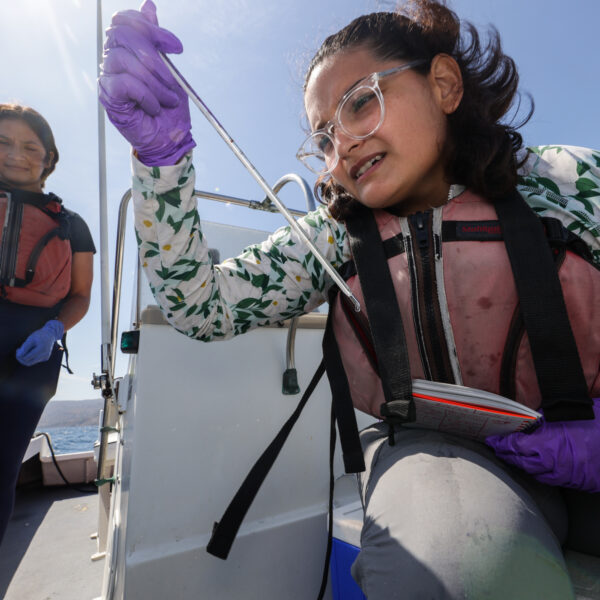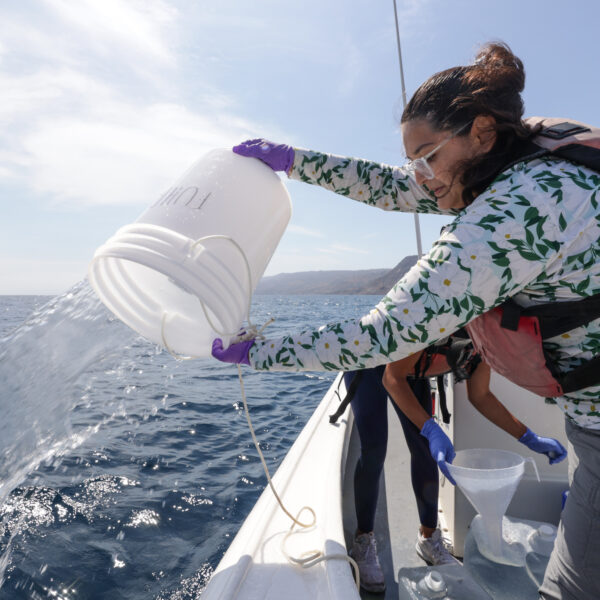Does the size of ocean bacteria matter to a sea virus?
My name is Melody Aleman. I am a first-gen 5th Year PhD Candidate in Dr. Jed Fuhrman’s lab at USC. I’m thankful to have been selected as a Wrigley Fellow this summer to conduct research in the field that contributes to my dissertation. My dissertation focuses on the ecological interactions between bacteria and viruses in the ocean.For those not familiar to marine microbiology, it may come as a shock to hear that in 20 drops (1 mL) of seawater there exists 1 million bacteria and 10 million viruses. But there is nothing to worry about, as most of these bacteria and viruses do not infect or otherwise harm humans. In fact, these microbes contribute to important biogeochemical processes in the ocean.

Bacteria represent the base of the marine food web in which they are consumed by plankton, plankton consumed by fish, and fish consumed by humans (or birds!). Viruses disrupts this chain by infecting bacteria, a process in which the genetic material (DNA or RNA) of the virus is inserted into the bacterial cell. The host bacteria’s cellular machinery is hijacked to generate more viral progeny, causing the cell the burst. Thus, the host’s cellular contents (organic matter) are exposed to the environment that may be taken up by other bacteria or sent further down the ocean via sinking. This is how biological carbon pump works, focusing on how carbon can transform from carbon dioxide in the atmosphere to organic carbon via photosynthesis by phytoplankton, and then ultimately be transported to the deep ocean.
While there are free-floating bacteria and viruses in the ocean, there are also lots of particles in the ocean that bacteria can attach and grow on. Wherever bacteria grow, there are viruses searching for a host to infect. That’s why I am interested in measuring rates of virus production based on the size class of the host. To achieve this, I’ve conducted 3 bottle incubation experiments over the summer.

Thanks to Wrigley Staff operating the boat, I first go out to my sampling location off the coast of Catalina Island where there is less of an influence of human activity and pollution. There, I toss a bucket over the side of the boat to collect 30 Liters of surface seawater and record its temperature.Back in the lab, I follow a dilution technique that reduces the amount of free-floating background viruses in my seawater samples. The first step is to concentrate my seawater sample through a filter with pores that are large enough to allow viruses to pass through (0.2 or 3 μm). 1 Liter of seawater is concentrated down to 100 mL. The second step is to generate virus-free seawater by pumping seawater through a series of filters. The last step is to combine 900 mL of virus-free seawater with 100 mL of concentrated seawater, so I can get back to 1 Liter total. I do this 3 times per size fraction, resulting in 6 incubation bottles.
Once my incubation bottles are set-up and the incubator is set to the sea surface temperature measured earlier, I can begin sub-sampling. I take samples for cell counts and for future DNA extractions. I do this at every-time point of my incubation experiment (0, 18, and 24 hours). The idea is that bacteria that were already infected by viruses at the beginning of the incubation will eventually burst. Thus, I can track the change in virus abundance overtime, which should increase by the end of the experiment.I use an epifluorescence microscope to manually count the number of bacteria and viruses that are present in my sample. I achieve this by staining the bacteria and viruses with a dye that binds to DNA known as SYBR Green I.

Besides conducting experiments, a huge part of my experience working at Wrigley this summer was being a mentor to my Research Experience for Undergraduates (REU) Student Taylor Trivino. I trained her in making SYBR microscope slides for her experiments focusing on optimizing this method. I remember being in her shoes as an REU student myself at Lamont-Doherty Earth Observatory working with Dr. Ajit Subramaniam. This is a full circle moment for me. I greatly appreciate her help with my experiments. I am also thankful for the helpful staff and all of the resources available at Wrigley to make this research possible.
